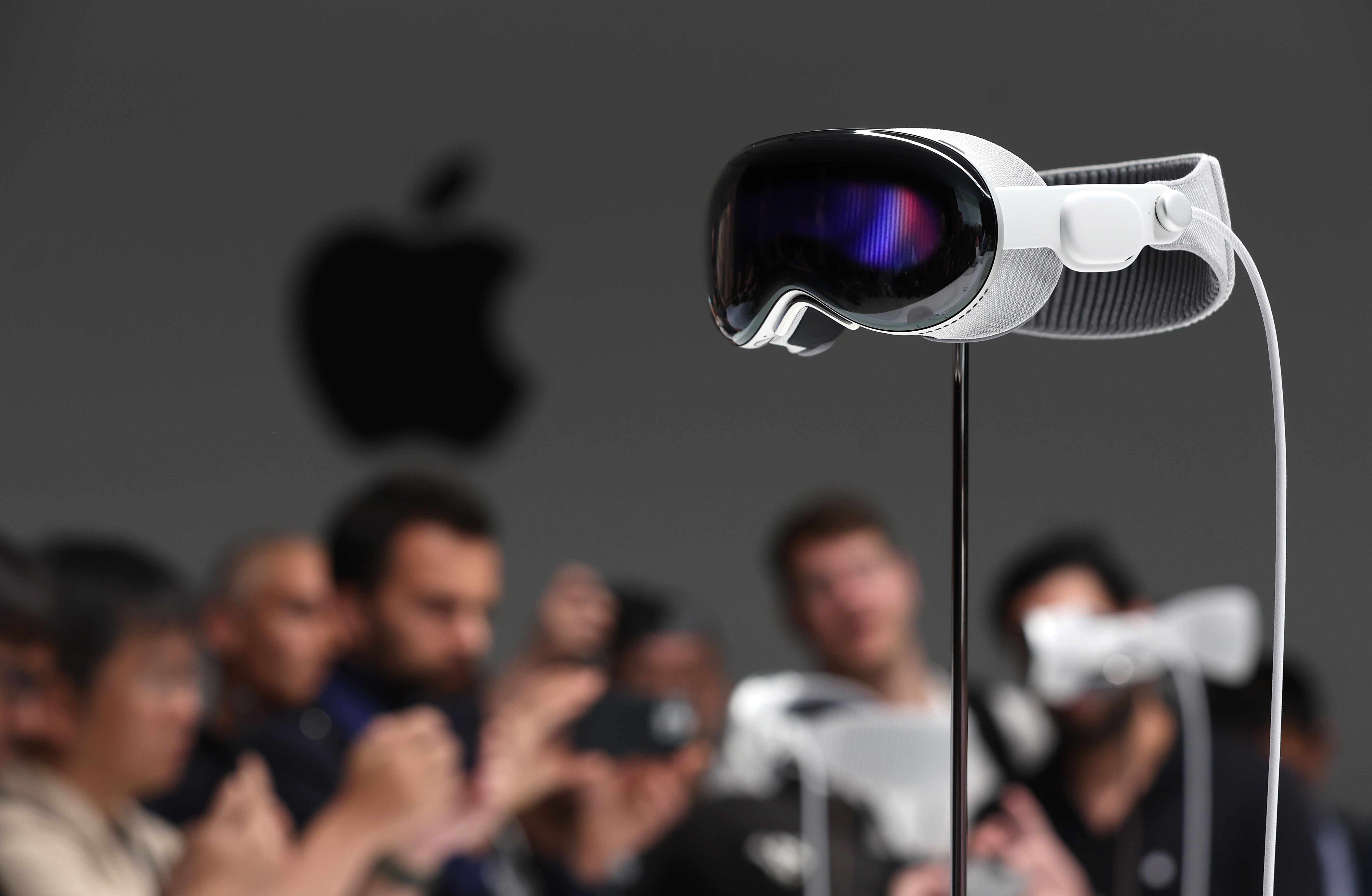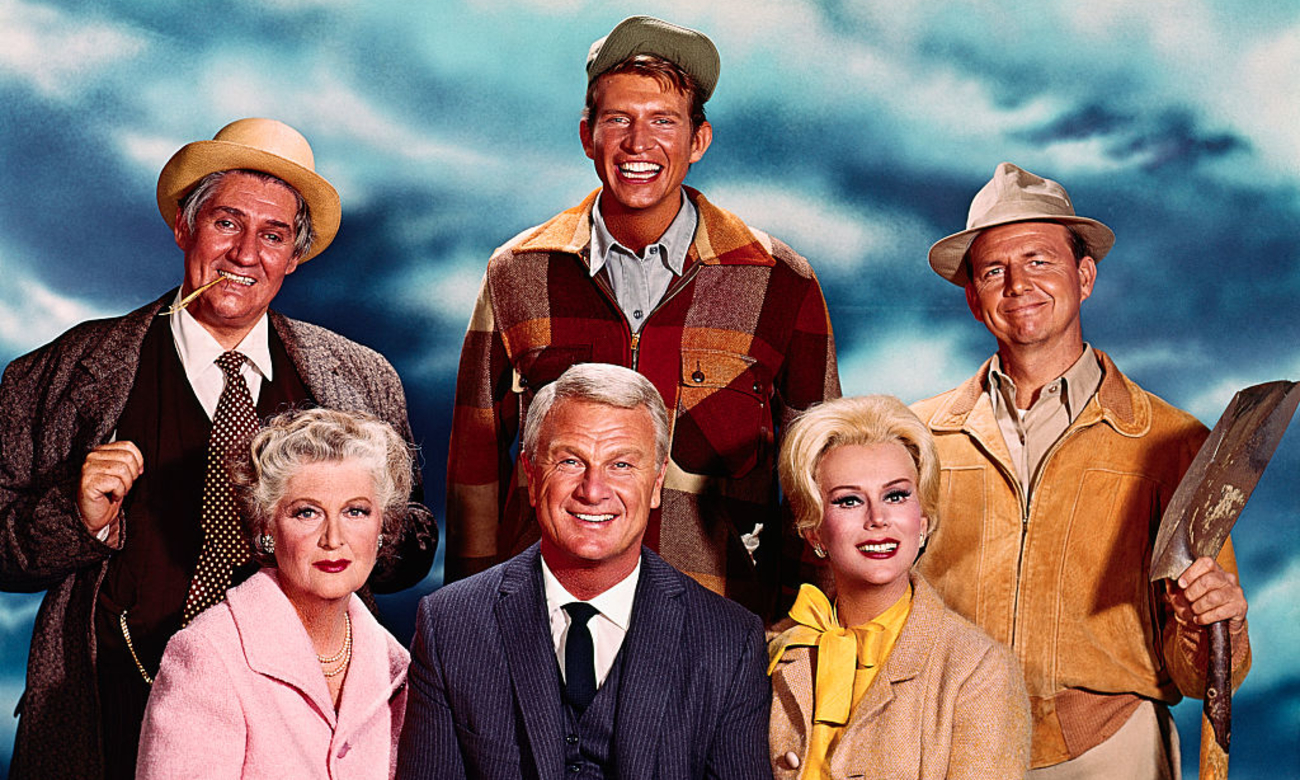
In Philip K. Dick's 1956 futuristic sci-fi novella Minority Report (famously adapted by Steven Spielberg in 2002 into an Oscar-nominated Tom Cruise movie), the savant children of those addicted to the fictional drug "neuroin" are born profoundly disabled, possessing only a super-power to see violent glimpses of the future.
Now, admittedly, what the more youthful Next TV immediately took out of that was curiosity about where to score a made-up illegal street drug.
But really, save for the ability to ramble on endlessly to our bored wives and adult children, and type into laptop computers, Next TV writers Daniel Frankel and David Bloom aren't all that much more able-bodied than Dick's tormented "precogs" were ... er, are going to be. So go ahead and lounge us in a gizmo'd-out hot tub with electrodes attached to our skulls, take some notes, then call your bookie and your broker.
We're all gettin' rich!
But seriously, these awesome powers of ours require an even-keeled, judicious mindset. Really, we only break them out for lazy, end-of-the-year theme columns.
DAVID BLOOM: Happy New Year, Dan! It’s that season when everyone makes fearless predictions for the year ahead. Given how bad 2023 was for so much of the streaming video industry, perhaps 2024 will be better. Or not! To start, it looks like the industry finally understands that many media companies did a dumb thing starting their own streaming services, instead of just taking big Netflix checks like in the old days. Those silly kids thought streaming was just more of what they already did, instead of a radically different business. Suits put to rest any illusions there.
Year five of the modern streaming era will feature billions of people streaming video everywhere from TikTok and YouTube on a $200 flip phone to $500 big-screen connected TVs to $3,500 Apple mixed-reality headsets to $100,000 self-driving cars (though Tesla won’t include Disney Plus anymore).
But we won’t be watching (and paying for) several sub-scale subscription services as much as they need us to do. That brings me to my first real prediction: Hard decisions get made in 2024. At least one big streaming service closes down, either before or as part of a merger that almost certainly will involve Paramount Global, or its controlling shareholder, Shari Redstone’s National Amusements.
Also read: Big Deal: Warner Bros. Discovery Reportedly in Merger Talks With Paramount
Latest reports were initial talks before Christmas with Warner Bros. Discovery. Entirely possible, given the deal-making fervor of WBD CEO David Zaslav and puppet master John Malone, but boy, that’s a lot of combined debt to wash out over the next few years. Thank goodness Zaz and Weeds know how to cut, cut, cut. Employees just love that. So do creative partners. Regardless, wildly undervalued Paramount likely gets sold for parts, with the streaming service the first casualty. BET is sold, possibly even before everything else. Apple buys the library. Baby mogul David Ellison or, more likely, nearby Netflix, buys the studio lot. WBD buys cash cow CBS, with its sports rights and a bunch of crowd-pleasing shows, including the Taylor Sheridan-verse. Or maybe Taylor Sheridan cuts out the middleman and buys CBS himself.

DANIEL FRANKEL: Well, David, for starters, we Southern Californians, nationally reviled as we are, can look out our windows today, witness the ongoing El Niño-spawned torrents, and safely predict about 12 more weeks of wet weather. We don't need to torture rodents to do it. Hard to believe we were killing our lawns just 18 months ago. But onto more destructive forces of nature and job creation ... If you were a Time Warner Inc. employee on October 22, 2016, the day your company agreed to be purchased by AT&T for $85 billion, and you still work for Warner Bros. Discovery today, how much job loss, uncertainty, anxiety, cardboard boxes, tearful goodbye hugs, big company memos, etc. have you experienced over the last seven-plus years?

When, after all this job and wealth destruction, does someone stand up to John Malone and David Zaslav and say, "No, you've done enough"? Listening to decidedly unenthusiastic equity analysts today, I'm going to validate your prediction that the big Warnamount merger doesn't happen, and instead, Shari Redstone is going to part out Paramount. We'll see assets like BET sold off to folks like Byron Allen. More broadly, investors will push for bundled unity. And I foresee the "Everything Platform" envisioned back in October by Jason Kilar being a forward-looking solution that the major conglomerates settle on. I don't think anybody can just ditch one of these big SVOD platforms at this point. Sure, they cost a fortune to maintain and fuel, but you don't just drive a Ferrari off a cliff. More M&A debt doesn't seem like the answer, either. But they've got to do something. You give me Disney Plus, Hulu, Max, Paramount+ and Peacock in a $30 bundled offering? Sure. And I'll never churn again, promise. What else you got, Carnac?
BLOOM: That’s Carnac the MAGNIFICENT to you, buddy. Not sure any of these streaming services counts as a Ferrari so much as a smog-spewing, suspension-challenged lemon swerving across the digital superhighway. If someone could get all five of the services you mentioned for a mere $30, I’m sure they would be happy to jump on the offer. I presume that offering is all ad-supported, priced to push scale for the resulting ad sales. I just don’t think it’ll be priced that cheaply, even as an introductory product. Something north of $49.99 appears more like a starting place, and that’s without add-ons for things like sports. And even if all these loss-making media companies manage to cooperate on this project, it doesn’t mean all of them also will maintain a standalone, pricey DTC service. They can’t afford to serve up an endless stream of cool new programs, along with marketing and customer support to keep audiences around. We’re already seeing how that works.

By the way, there’s precedent for Kilar’s vision of the studios jointly offering their wares through a single online interface. It was called Movielink, was backed by five studios, and lasted five years before it was sold to Blockbuster, never a good sign in 2007. It was dead within a year. Couldn’t they effectively do the same thing with deals through Amazon, YouTube, Verizon, and Apple as bundlers? Given how studies collectively handled the strikes this year, let’s just say I’m skeptical of anything more collegial than that.
Also read: Blockbuster Dumps Movielink Tech After A Few Months; Goes With Cinemanow Instead
Next up for my predictions: a buffalo stampede to ad-supported everything. Roku named the CTV ad stampede one of its top five trends for 2024. The biggest video streaming platform in the world’s biggest advertising market is right. Niche channels will have up their ad game even more, serving high-value, highly targeted advertising to highly specific audiences. It's their best hope to survive for a few more years.

That even includes ad-supported semi-holdout Apple. Why? Because even $3 trillion companies need to keep growing to keep their market cap at stratospheric levels. Apple faces a growing list of expensive headaches: the Epic-Alphabet lawsuit could impact billions of dollars that Google pays Apple; Apple’s own App Store is under regulatory assault; Apple’s gigantic China market is eroding thanks to competitive Huawei phones boosted by a patriotic buy-local pitch; even the recent patent case that halted Apple Watch sales right before Christmas matters at the margins. Apple needs new revenue sources. The Vision Pro mixed-reality headset might do it eventually, but at $3,499, that’s going to take a while. So, more ads. Like everyone else.
FRANKEL: I did notice that Apple leaked some streaming audience metrics. I'll add to this predictive maelstrom by projecting that bullshit self-reported programming metrics from the major U.S. SVODs, lacking context and dare I say credibility, will be all the rage, as soon as the first quarter.
Also read: Deep Diving Into Netflix’s Big, Non-Contextualized Data Dump — a Huge Flex or Giant Head Fake?
But reigning in the discussion back to Apple ... it does seem like the gravity of global consumer demand is going to pull the shear mass of its $3.17 trillion market cap back to earth at some point. ... Unless, you know, the Vision Pro takes off or something. The innovation cycle on smart phones seems kind of over. But the Vision Pro is too expensive to become a global phenomenon. It's one thing to pay $22 a month for the newest iPhone. But you're asking teenagers to pay $200 a month to finance a headset?
Also read: Apple’s sales fall for the fourth straight quarter despite a strong start for latest iPhones
BLOOM: The Vision Pro is obviously priced for business, and early adopter fan boys like (cough) me. As such, this first model won’t be mass market almost by definition. But word has already gone out that they’re building a succeeding model that likely will be priced more like a mid-tier computer, appropriate given how much computing power is stuffed into these headsets. It’s that model and ones like it that have a chance to break out, especially if everyone realizes they already can capture spatial video right now on the latest iPhones. Imagine the value of, say, capturing your grandmother this holiday season talking about her life and experiences, and then being able to watch it in subsequent years on your headset. There will be, ahem, other uses for extremely personal spatial video that are traditionally also much admired by early adopters. So, that can be a thing sooner than perhaps it appears obvious.
Meanwhile, the SVOD business’s burgeoning interest in self-reported viewership data is worth not very much to all the people who most care: advertisers, marketers, creative partners and journalists/ It’s almost enough to make one pine for the days of Nielsen primacy. So, on a related note, this is going to be a challenging year for FAST linear channels that launched seemingly everywhere in the past several months. If 2023 was the year everyone started a free, ad-supported linear TV network (or 30, or 175), 2024 will be the year everyone starts killing them off.
Also read: Magid Streaming Survey Sees More Churn, FAST Channels in 2024
Consumers can’t/don’t want to watch 4,000 FAST channels. Like every other media distribution power curve, viewership will coalesce around a relative handful of channels. Everybody else is facing a big cull and oblivion. One response by platforms and channel operators will be a lot more pop-up operations, tied to a season or theme or single program or creator (the Norman Lear channel would have been hot the past couple of weeks, for instance). These will, I expect, routinely appear for a few weeks or months, then disappear.
FRANKEL: FAST is all the same repeats, mashed up and packaged in different ways. How many Green Acres channels do I need? How much access to Tastemade do I want. And besides, who is going to underwrite these enterprises with players like Netflix, Disney and Apple in the advertising market with their hands out? I mean, ad dollars aren't infinite.

BLOOM: It will be a much bigger ad-dollar pie by this time next year, I expect, but the FASTs will definitely pull back to a more manageable number. But thanks in part to the lower price points that ads will finance, and also because of overseas markets, Netflix will top 300 million subscribers worldwide. Fewer competitors will help, and so will its increasingly sophisticated video games, live experiences and a stable of sports-related content. I still don’t think Netflix buys live sports rights, preferring to let the air slowly sputter out of these over-inflated balloons, then see where value presents in a couple of years.
Also read: Netflix Has Early Interest in the NBA's New In-Season Tournament
More generally, sports will be among the most interesting and transformed sectors on “TV.” Amazon essentially takes over Diamond Sports’ regional sports networks, and the leagues exhale, relieved to have a solvent partner that also can push their teams, brands and merchandise far beyond U.S. shores. It also positions Amazon as the go-to joint for many kinds of sports ‘casts. Don’t forget that Amazon CEO Andy Jassy is a sports fan. He’s even a minority investor in the NHL’s Seattle Kraken.

ESPN re-ups its NBA deal, Amazon buys the in-season tournament package, and WBD decides it can’t afford to keep up its share and do other deals, too, especially if those deals include the CBS sports rights. Alphabet’s various YouTube components step in, to keep up with Amazon. I don’t expect Iger and Jimmy Pitaro to finish the work in 2024 needed to spin out ESPN as a separate company, or launch the cable version of ESPN fully into a stand-alone streaming service, but 2025 is go time, allowing Iger to retire for real in 2026, after training up Kevin Mayer or Dana Walden as his COO/successor.
FRANKEL: That potential Bally Sports deal looks like a winner for Amazon, but what are the chances that the NBA, MLB and NHL -- which get all their BS local rights back at the end of their seasons -- go along with it?
BLOOM: I’d say the individual teams are dopes if they don’t figure out a way to build a sustainable relationship with Amazon. Are they going to count on local broadcasters to replace the revenue they were getting from their RSN relationships. That doesn’t necessarily mean Diamond remains part of the relationship, but you can imagine a deal where there’s still an RSN in a given market, and an online component served up by Amazon. That would be a new structure, but one that actually sustains the legacy relationship and customers, while paving the way for the future. Disney/ESPN will be figuring out much the same thing on a national and international level.
I’d say the individual teams are dopes if they don’t figure out a way to build a sustainable relationship with Amazon.
David Bloom
FRANKEL: This one is hard to figure out. The way the short-term deals with both the leagues and pay TV carriers have shaken out, Diamond and Bally liquidate after baseball season ends next October, and all the leagues get their local TV and streaming rights back. So I would imagine it's really a discussion between the leagues and Amazon at this point. But I'm going to make our little talk a little jagged, and revert back to Apple. The wife and I, having exhausted the final episodes of The Crown on Netflix and said goodbye to a truly great historical drama series, well, we fired up Skydance's The Family Plan on Apple TV Plus. It's like Vince Lombardi's sweep. You've seen this True Lies format exploited over and over. You know everything that's coming. And Mark Wahlberg isn't going to surprise anyone at this stage of his career with actual acting -- he's pretty much, like Dwane Johnson usually is, gonna be Mark Wahlberg in everything you see him in. But somehow, this whole paint-by-numbers genre exercise works. We were entertained, despite ourselves. And we were apparently not alone. Apple said this film had its best debut ever. So I'm predicting Apple TV Plus doesn't go away in calendar 2024. (I know, bold!)
BLOOM: Bold indeed! I’m reeling from the sheer bold-acity of it all. I think the bolder prediction, though, is that Apple TV Plus pivots to the middle to attract a much bigger audience. TV Plus' first four years were all about signaling “premium” and “quality.” Their small, high-dollar portfolio of projects won an Oscar Best Picture and two Best Comedy Emmys, among other big iron. Mission accomplished. But if Apple adds ads, it’s going to need a lot more people to watch them than TV Plus has. CBS lived on the fat of the land for decades by consistently feeding audiences broad, familiar genre exercises featuring much-liked faces doing things that audiences enjoy. Wahlberg is a poster child for this kind of entertainment, So is Adam Sandler at Netflix (though he does even more, like the hugely popular animated feature Leo) . And that’s the point.

These projects fill a comfortable middle tranche of the catalog, giving lots of people something else to occupy an evening enjoyably after they’ve watched the expensive stuff. Apple needs more of that on top of its pricey, prestige shows. Which is also why I think they should buy the CBS catalog when it hits market.







